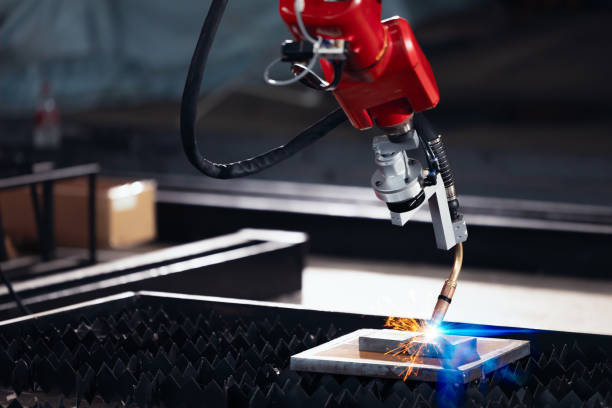Laser welding, a precise and efficient joining technique, has revolutionized fabrication processes across various industries. In this article, we explore how laser welding can transform your manufacturing workflow, improve product quality, and enhance overall efficiency.

I. Challenges with Traditional Welding Methods
Traditional welding methods, such as TIG (Tungsten Inert Gas) and MIG (Metal Inert Gas), have their limitations:
1) Complexity and Skilled Labor Shortage:
TIG (Tungsten Inert Gas) Welding: TIG welding demands highly skilled operators due to its intricate process. The welder must manually feed the filler rod while maintaining precise arc length and angle.
MIG (Metal Inert Gas) Welding: Although MIG welding is more straightforward, it still requires skilled personnel to adjust parameters, manage wire feed, and ensure proper shielding gas flow.
2) Material Waste and Rework:
Traditional welding methods can result in material waste due to imprecise welds, spatter, and excessive heat input.
Rework—fixing defects or subpar welds—adds significant costs and delays to fabrication projects.
II. Advantages of Robotic Laser Welding
Robotic laser welding offers several advantages:
1) Repeatability and Consistency:
Robotic systems consistently produce high-quality welds with minimal variation.
Precise control over parameters ensures uniform results, even in complex geometries.
2) Increased Welding Speed:
3) Labor Cost Reduction:
4) Material Waste Reduction:
III. Types of Laser Welder Technologies
Different laser welding methods exist, including:
1) Fiber Laser Welding:
Utilizes fiber-optic cables to deliver laser energy to the workpiece.
Ideal for precision welding, especially in thin materials.
Offers high beam quality and efficient energy conversion.
2) CO2 Laser Welding:
Uses carbon dioxide lasers for deep penetration welding.
Well-suited for thicker materials and industrial applications.
Provides excellent weld depth and speed.
3) Laser-MIG Composite Welding:
Combines laser and MIG (Metal Inert Gas) welding.
Enhances productivity by leveraging the benefits of both techniques.
Achieves deeper penetration and improved weld quality.
Remember, choosing the right laser welding method depends on your specific application and material requirements. Each technology has its strengths, so consider factors like material thickness, joint design, and production volume.
IV. Robotic Solutions vs. Cobot Solutions
Before we compare robotic solutions and cobot solutions, let's learn cobot basics first. Cobots, also called collaborative robots, have the following features:
Designed for Collaboration: Cobots are specifically engineered to work alongside humans. They are safe, easy to use, and flexible.
User-Friendly Interfaces: Cobots have intuitive interfaces, making programming and operation accessible to everyone.
Safety Features: They can detect and react to human presence, ensuring safety in shared workspaces.
Small Footprint: When paired with positioners, cobots handle various tasks with precision in a compact space.
Adaptability: Cobots are suitable for tasks that require quick changes and adjustments.
Then, let's see the differences between laser welding using traditional robots and collaborative robots (cobots):
1) Traditional Robots:
Heavy-Duty Operations: Traditional industrial robots excel in speed and capacity, making them ideal for large-scale manufacturing.
Specialized Programming: They require specific programming and operate independently from human workers.
Efficiency and High Volume: Traditional robots focus on efficiency and high-volume production.
Safety Considerations: Due to their power and speed, traditional robots need separate areas (robot cells) to ensure human safety.
Fixed Installations: Unlike cobots, they require fixed installations.
2) Laser Welding Cobots:
Flexibility: Programming a laser welding cobot for a new welding task is significantly faster and doesn’t require extensive retooling.
Productivity and Consistency: While bridging the gap between human welders and traditional robots, laser welding cobots offer productivity gains and consistent results.
Minimized Risks: Robotic laser welding reduces exposure to hazards by keeping humans away from dangerous parts of the process.
Skilled Worker Focus: Cobots handle tough, hazardous work, allowing skilled workers to focus on other critical tasks.
V. Cobot Systems’ Laser Welding Solution
Consider exploring cobot-based laser welding solutions. These cobots are user-friendly, easy to program, and can be quickly integrated into existing workflows. Look for systems that offer:
1) Plug-and-Play Integration:
Cobot Systems’ laser welding cobots require minimal setup time.
Simply connect the cobot to power, program it, and start welding.
2) Safety Features:
3) Versatility:
Cobot Systems’ cobots handle various welding tasks:
Their adaptability makes them ideal for dynamic production environments.
VI. Conclusion
In the ever-evolving landscape of fabrication, laser welding stands as a transformative force. As we’ve explored, robotic laser welding systems offer precision, speed, and reduced material waste. Collaborative robots (cobots) further enhance flexibility and ease of programming.
Manufacturers must embrace this technology to achieve higher productivity, cost savings, and consistent weld quality. Attend welding exhibitions, stay informed about industry trends, and consider integrating laser welding solutions into your fabrication process.
Remember, precision matters—choose laser welding for a brighter future in manufacturing!
Related articles:
1. Exploring Laser Welding Machines: Benefits, Costs, and Top Picks
2. Prices of All Types of Laser Welding Machines for Reference
3. Solutions to Oil Leakage in Pipeline Continuous Laser Welding
4. Robotic Laser Welding: The Future of High-Speed Manufacturing
5. Laser Welding: Precision Fusion for Modern Manufacturing




